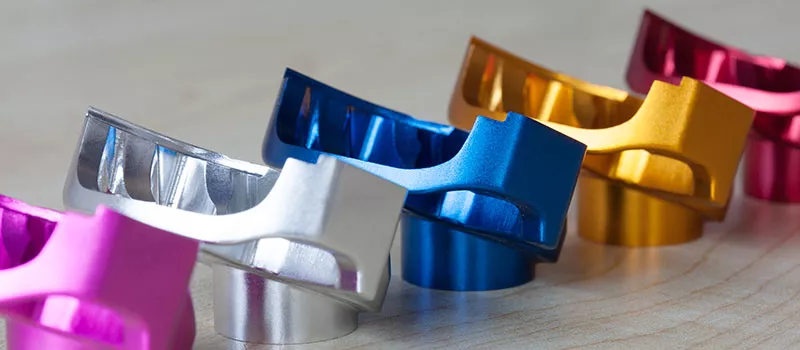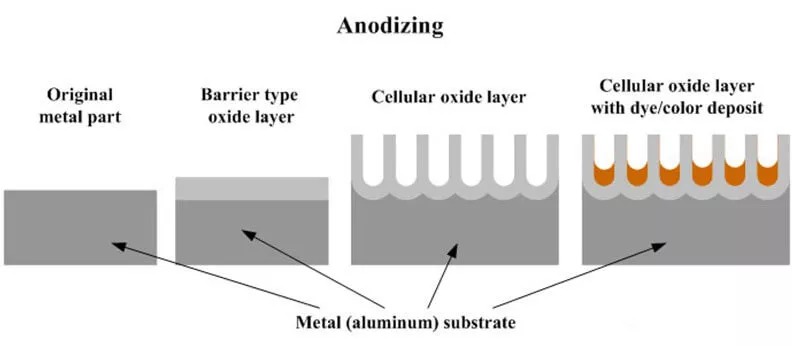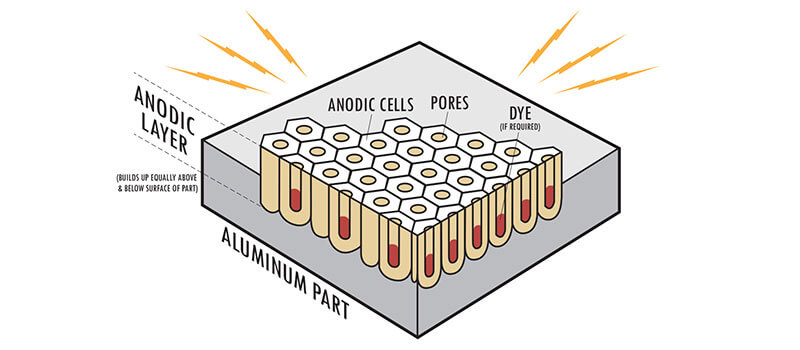Specializing in CNC machining, 3D printing, urethane casting, rapid tooling, injection molding, metal casting, sheet metal, and extrusion.
When the requirement arises for metal prototypes or parts that demand exceptional mechanical attributes and specialized aesthetic designs, the practice of anodizing aluminum emerges as an outstanding choice. Anodization involves creating an oxide layer on a metal component, elevating its corrosion resistance, enhancing visual characteristics, and fortifying its surface against scratches.
Anodizing aluminum represents a remarkably durable post-processing technique. Not only does it augment the properties and appearance of a component, but it also facilitates improved adhesion for paint primers and adhesives. This method employs anodic films that yield distinctive aesthetic effects, ranging from transparent coatings that reflect light to dense coatings that can embrace dyes.
While anodizing aluminum does impact the mechanical qualities of metal parts, it preserves the inherent appearance of the material. While this technique can be extended to other metals—such as titanium, zinc, and magnesium—aluminum stands as the most prevalent choice.

As an integral part of Fuerd's comprehensive range of premium surface finishes, our anodizing aluminum service empowers you to amplify the functionality and visual appeal of your metal prototypes and parts. To guide your decision-making process concerning post-processing, we present a comprehensive overview of anodizing aluminum.
The Anodizing Process Unveiled
The anodization of aluminum components necessitates a meticulous sequence of steps. The surface is initially cleansed and rinsed before being immersed in an electrolytic solution, most commonly sulfuric or chromic acid. This process establishes an electrically conductive layer rich in positive and negative ions.
How does this process unfold? As anodization initiates, a positive electric charge courses through the aluminum, while plates in the electrolyte receive a negative charge. In essence, the electric current compels positive ions to gravitate toward negatively charged plates, whereas negative ions migrate toward the aluminum component, serving as the positive anode.
This orchestrated electrochemical reaction prompts the emergence of pores on the aluminum surface, facilitating the escape of positive ions. Arranging themselves in a uniform geometric configuration, these pores extend into the substrate of the part. The interplay between the aluminum surface and negatively charged ions generates a barrier layer, known as the surface layer in the anodizing aluminum process, bestowing parts with resistance to corrosion.
Currently, four distinct variants of the anodizing aluminum process exist, each presenting unique advantages:
Anodized Type I: The foundational type utilizes chromic acid to form a thin and malleable anodic layer on aluminum parts.
Anodized Type II: Utilizing sulfuric acid instead of chromic acid, Type II engenders a thicker anodic layer, rendering it conducive to coloration.
Anodized Type III: Similar to Type II, this method employs sulfuric acid to generate a denser anodic layer, suitable for coloration. It's commonly referred to as "hard anodizing."
Chemical Film / Alodine: This approach involves coating the part with alodine to yield results akin to anodization.
While chromic acid enjoyed widespread usage during the inception of the anodizing aluminum process in the early 1900s, contemporary parts are predominantly anodized with sulfuric acid (Type II and Type III).
Adding Vibrancy through Anodizing
Anodizing aluminum components extends diverse options for incorporating color. The coloration procedure entails injecting pigments into the vacant pores of the component. Once these pigments reach the surface, they are sealed in place, preserving the chosen color. This results in a visual effect that maintains its vibrancy and remains impervious to scratching, ensuring your components retain their pristine appearance.


Benefits of Anodizing Aluminum Components
Unbeknownst to many, products and parts subjected to the anodizing aluminum process are omnipresent in daily life. This technique finds broad application across an array of sectors, contributing to components frequently found in aircraft, consumer goods, sports equipment, and electronics, among others.
Anodizing aluminum parts delivers an array of advantages, both visual and mechanical. Primarily, anodized aluminum parts exhibit exceptional durability and hardness. This property, coupled with improved resistance against abrasion and corrosion, renders the technique suitable for parts exposed to challenging environments. Furthermore, it provides effective thermal insulation for metal parts.
The anodizing aluminum process will help metal parts last longer than raw parts. The coating is much thinner than paints and powders, while still supplying a much harder surface as well.
Another benefit of anodizing aluminum parts is that it offers an environmentally-friendly finish, making it easily recyclable. And, perhaps most importantly, the post-processing technique is affordable compared to painting and powder coating.
Should You Anodize Your Aluminum Parts?
Now that you know more about anodizing aluminum, you can decide whether or not this process is right for your parts. If you need functional aluminum parts that will face corression or wear, such as aircraft parts or consumer goods, this post-processing technique will satisfy your needs. There’s also a visual appeal to anodizing aluminum, particularly because you can add color to your parts while keep the metallic sheen intact.
If you want to learn more about how this technique can help enhance your prototypes and parts, contact our expert team to discover how anodizing aluminum can enhance your own production plans.
Dongrun Casting have 20000 square meters facility houses and 200 production & test equipment, From quotation and tooling design to casting and finished machining, we can work with you at every stage. We serves wide range of industries-from Fortune 500 corporations to small and midsize OEMs. Our products includes: Automotive&Trucking, Electric Utility & Communications, Metering System, Hydraulic Industry, Medical Devices, Lighting, Fuel and Gas Pressure, Furniture parts.
More Details : www.dongruncasting.com
